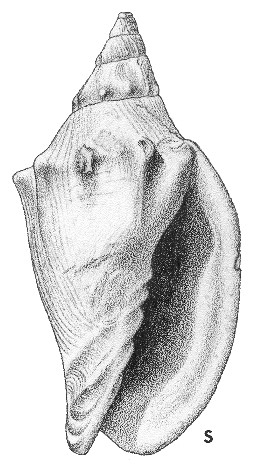
Revised descriptions of New Zealand Cenozoic Mollusca from Beu and Maxwell (1990)

 | Revised descriptions of New Zealand Cenozoic Mollusca from Beu and Maxwell (1990) | 
|
  (Pl. 21s): GS11174, J41/f8237, shellbed on Fallon's property, Ardgowan, Oamaru, Altonian (GNS) |
Beu & Maxwell (1990): Chapter 11; p. 206; pl. 21 s.
Synonymy: Fulgoraria (Alcithoe) arabica var. turrita Suter 1917, p. 39; F. (Alcithoe) turrita; Spinomelon turrita; Alcithoe familiaris Marwick 1926a, p. 291-292; Alcithoe (Alcithoe) turrita, Beu & Maxwell 1990, p. 206, pl. 21s
Classification: Volutidae: Zidoninae
Description: Moderately large for subfamily (height 80-120 mm), biconic to fusiform, spire 0.3-0.45 total height. Protoconch not known. Teleoconch of about 6 whorls, early whorls apparently lightly convex, later whorls becoming increasingly more strongly shouldered (at 0.2-0.5 whorl height on spire), sutural ramp flat or concave. Last whorl weakly excavated, contracted gradually to relatively broad anterior end. Axial sculpture commencing as narrow costae reaching from suture to suture but gradually becoming tubercular on shoulder angle and obsolete on ramp; last whorl with 7-11 strong, laterally compressed tubercles with broad interspaces, in some shells restricted to periphery, in others extending anteriorly as low costae. Aperture rather large; anterior notch deep, fasciole prominent, bordered above by thin, sharp ridge, below by a more prominent but more rounded ridge. Columella almost straight except anteriorly where it is broadly twisted to right, in well preserved shells extending further anteriorly than outer lip; with 4 or 5 plaits, the lowermost and — in shells with 5 plaits, the topmost — considerably weaker than the others. Inner lip callus moderately thick at posterior end in some shells, a thin glaze below. Outer lip only slightly thickened and weakly reflected, broadly angled at periphery.
Comparison: Alcithoe turrita is very similar in shape and sculpture to some of the more strongly sculptured forms of A. arabica (Pl. 49d), but differs in having a much thinner inner lip callus. In A. arabica the callus is particularly thick over the columella and obscures the lower margin of the fasciole, and in many shells it forms a projecting plate or collar over the neck. Although none of the specimens of A. turrita retain the protoconch, its great similarity to A. arabica makes assignment to Alcithoe almost certain. A. turrita is very rare at Bluecliffs, so little is known of the range of variation there, bat apart from its relatively slender shape and tall spire, the holotype is very similar to specimens of A. familiaris from Ardgowan. In view of the considerable variation in such characters as shape and spire height in other species of Alcithoe, the differences between A. familiaris and A. turrita are here considered not to be taxonomically significant. The taxonomy of Alcithoe is in an unsatisfactory state, but there can be little doubt that there are far more available names than there are recognisable taxa in the genus. Marwick (1926a) described no fewer than 12 nominal species of Alcithoe (in addition to A. turrita) from the Otaian or Altonian of North Otago and Canterbury, and Laws (1932, p. 194) described an additional Altonian species. Of these 14 "species", eight have been assigned to Alcithoe (sensu stricto), the others to the "subgenus" A. (Leporemax) (see below), but this is now regarded as a synonym of Alcithoe on the basis of a molecular phylogeny. A. familiaris is here synonymised with A. turrita; a preliminary analysis of the remaining nominal species of Alcithoe suggests that only one taxon is involved, and for this Beu & Maxwell (1990) selected the name A. cylindrica Marwick (1926a, p.290) (type locality, Target Gully Shellbed). Synonyms are A. wekaensis (Weka Creek), A. compressa (Target Gully Shellbed), A. armigera (Ardgowan Shellbed), A. robusta (Mt Harris) and A. sequax (Mt Harris) (all of Marwick 1926a). A. cylindrica is readily distinguished from A. turrita by its much more robust shell, its thicker inner lip callus, its very thick outer lip, its more constricted aperture, its less prominent fasciole, and its thicker, more closely spaced columellar plaits.
Alcithoe is first recorded — somewhat doubtfully — from the Duntroonian (see Pl. 15m), and is the most characteristic New Zealand Cenozoic-Recent volute taxon from Altonian onwards, although it is not recorded from warm-water Early and Middle Miocene faunules from Southland or Northland. The origin of the genus is uncertain. The strong peripheral tubercles, deep anterior notch and prominent, ridge-margined fasciole of A. turrita possibly indicate derivation from a species of Mauira, but A. cylindrica, with its less tubercular sculpture and less prominent, more rounded fasciole, suggests derivation from Spinomelon.
Distribution: Otaian- Altonian; Mount Harris Formation, Bluecliffs, Otaio River, Otaian (type locality of F. turrita); Mt Harris, South Canterbury, Altonian (type locality of A. familiaris); Dyer's Run, Waihao Valley; Ardgowan Shellbed; ?basal shellbed, Enys Formation, junction of Porter and Thomas Rivers, Castle Hill Basin.
Cite this publication as: "A.G. Beu and J.I. Raine (2009). Revised
descriptions of New Zealand Cenozoic Mollusca from Beu and Maxwell (1990). GNS
Science miscellaneous series no. 27."
© GNS Science, 2009
ISBN
978-0-478-19705-1
ISSN 1177-2441
(Included with a PDF facsimile file
copy of New Zealand Geological Survey Paleontological Bulletin 58 in CD version
from: Publications Officer, GNS Science, P.O. Box 30368 Lower Hutt, New
Zealand)